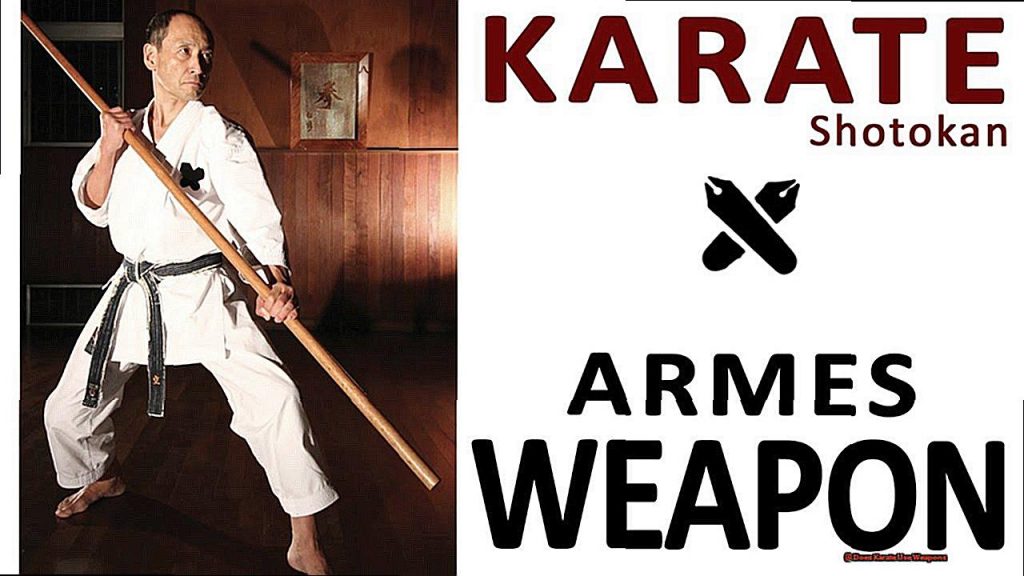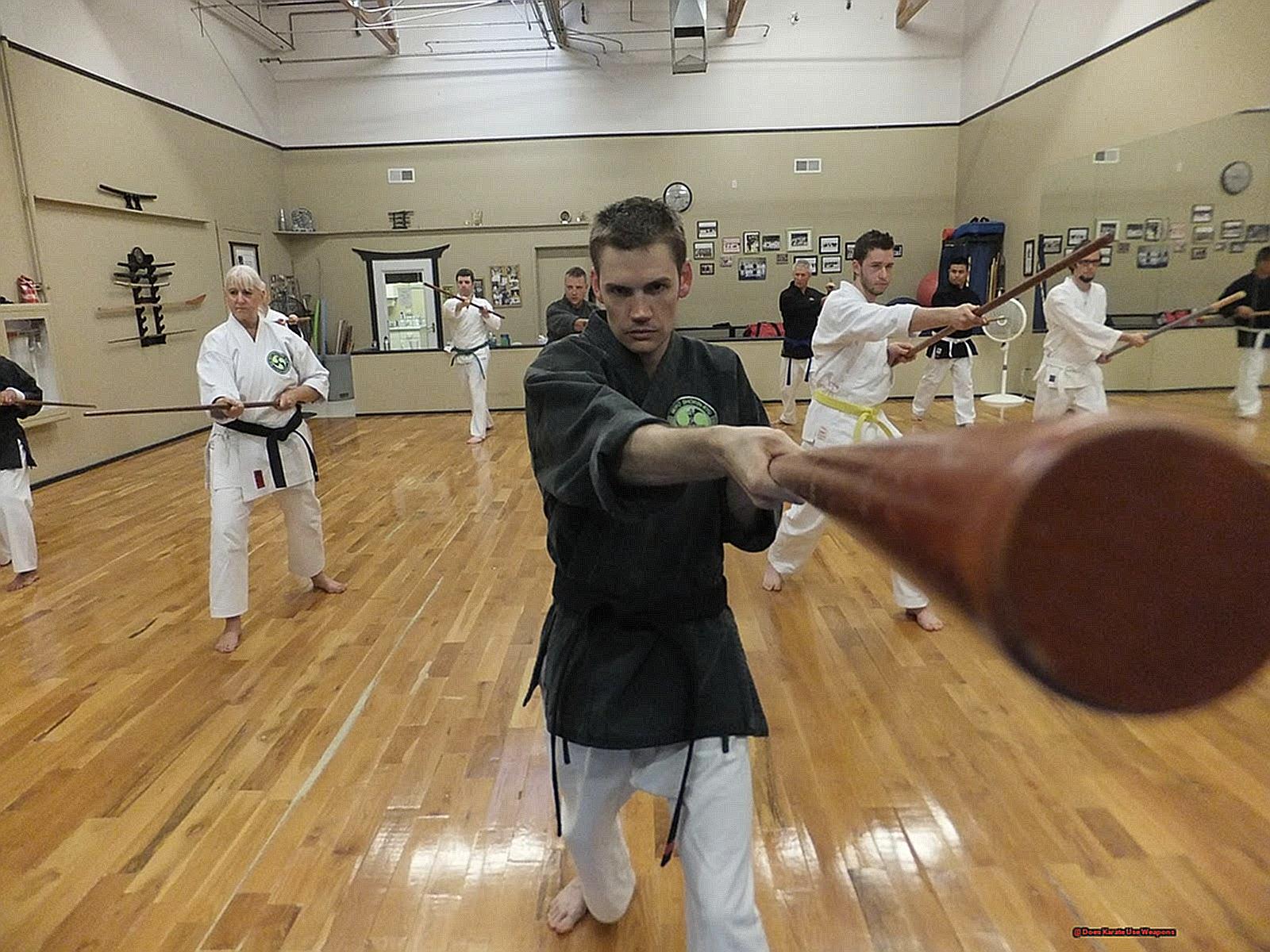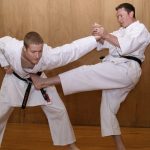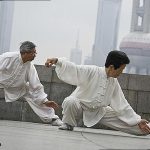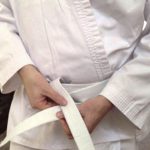Karate, the ancient martial art born in the island of Okinawa, Japan, has captured the hearts and minds of people all around the world with its powerful techniques and disciplined approach. Whether you are a beginner or a seasoned practitioner, there is always something new to discover in this dynamic art form. And one aspect that never fails to fascinate is the use of weapons.
For centuries, weapons have been an integral part of karate training. From traditional Japanese weapons like swords and staffs to more modern tools like nunchucks and tonfas, each weapon requires skill, precision, and control to wield effectively. But beyond their physical prowess, these weapons hold a deeper purpose in enhancing both physical and mental discipline.
Each weapon has its own unique purpose and technique. The swift strikes of nunchucks require coordination and agility while the precise movements of a bo staff demand strength and balance. By incorporating these weapons into their training, practitioners not only improve their self-defense skills but also develop a heightened sense of focus and discipline.
In this blog post, we will delve into the history, purpose, and techniques behind some of the most commonly used weapons in karate. So whether you are curious about trying out a new weapon or simply want to deepen your understanding of this ancient practice, join us as we explore the fascinating world of karate and its use of weapons. So grab your gi and get ready for an enlightening journey.
Does Karate Use Weapons?
Although traditional karate does not typically involve weapon training, some modern variations, such as Kobudo, do incorporate weapons into their curriculum. These weapons provide a unique challenge and add another layer to the practice of karate.
One of the most common weapons used in Karate is the bo staff. This long wooden stick is used for striking, blocking, and trapping and is often used to improve balance and coordination in karateka. It is also utilized for practicing strikes, blocks, and trapping techniques. In some styles, the bo staff is even used to simulate attacks from multiple opponents.
Another weapon commonly used in karate is the sai. This short, three-pronged weapon is used for blocking, striking, and trapping. Training with the sai is believed to improve grip strength and control while also promoting forearm conditioning. Similar to the hands, the sai can be used for striking and blocking techniques. It can also be used to trap an opponent’s weapon or limbs.
The tonfa is another short wooden stick often used in karate. It has a handle that allows for blocking and striking techniques. Like the sai, tonfa training aims to improve grip strength and forearm conditioning. Some styles also use this weapon to trap or disarm an opponent’s weapon.
Aside from these three weapons, there are several others commonly used in karate such as swords, spears, sticks, staffs, blunt weapons, tanto (dagger), nunchaku (nunchuks), shurikens, surujin, and kama. These weapons are usually incorporated into modern variations of karate that focus on weapon training.
Weapon training in karate not only improves balance, coordination, strength, and control but also promotes discipline and respect for these objects. As with any aspect of karate practice, mastering weapon techniques requires dedication and patience.
The Influence of Chinese Martial Arts on Okinawan Karate Techniques
The impact of Chinese martial arts, most notably Kung Fu, is evident in the utilization of weapons within Okinawan karate techniques. The incorporation of different weapons, including the bo staff, sai, nunchaku, and tonfa, is a testament to this influence on the practice of karate. These weapons not only improve one’s physical capabilities but also instill discipline and reverence for these objects.
One cannot deny that the incorporation of weapons in Okinawan karate has been greatly influenced by Chinese martial arts. This is especially noticeable in the use of the bo staff, a long wooden weapon that is often used in Kung Fu. Similarly, the sai, a small dagger-like weapon, has its roots in Chinese martial arts and has been adapted into Okinawan karate techniques.
Another weapon commonly found in Okinawan karate is the nunchaku, a two-sectioned staff connected by a chain. This weapon was originally used in Chinese martial arts and has now become an integral part of karate training. Similarly, the tonfa, a wooden baton with a handle perpendicular to the shaft, has its origins in Chinese martial arts and has been incorporated into Okinawan karate for its defensive capabilities.
Aside from enhancing one’s physical abilities, the use of weapons in Okinawan karate also promotes discipline and respect for these objects. In Chinese martial arts, weapons are not simply tools for combat but are also seen as extensions of oneself. Thus, incorporating them into karate training teaches practitioners to treat these objects with respect and responsibility.
In conclusion, it is evident that Chinese martial arts have greatly influenced the development of weapons within Okinawan karate techniques. The incorporation of various weapons not only enhances physical abilities but also instills important values such as discipline and respect.
Traditional Karate Styles and Their Emphasis on Unarmed Combat
The historical importance of traditional forms of karate and their unwavering focus on unarmed combat can be traced back to the Ryukyu Kingdom of the 17th century. During this time, strict bans on weapons prompted the evolution of self-defense techniques using only one’s hands and feet. This emphasis on unarmed combat was further influenced by the exchange of culture and trade with Chinese martial arts. Additionally, the creation of various styles or schools of karate also played a role in promoting discipline, respect, and self-control, which mirrored the values held by the people of Okinawa.
In fact, the word “karate” itself is derived from the Japanese phrase “empty hand,” symbolizing the art’s emphasis on using one’s body as a powerful tool for defense. This concept is deeply ingrained in traditional karate styles, which place great value on developing physical strength and control through rigorous training.
One example of a traditional karate style is Goju-Ryu, which was founded by Chojun Miyagi in Okinawa in the early 20th century. This particular style focuses on utilizing strong stances and circular movements to generate power and strike effectively. It also places great emphasis on breathing techniques, known as “kiai,” which are used to focus energy and enhance strikes.
Another style is Shotokan, which was developed by Gichin Funakoshi in Tokyo during the same period. Shotokan emphasizes long-range techniques and linear movements, as well as strong kicks and punches. It also places great importance on kata, or forms, which are predetermined sequences of movements used for training and self-improvement.
Overall, traditional karate styles have a rich history rooted in discipline, self-control, and unarmed combat.
Modern Variations of Karate that Incorporate Weapon Training
Modern adaptations of karate that involve weapon training include kobudo (traditional Okinawan weapons) and competitions that exclusively feature weapons. These variations have evolved over time, gaining popularity among practitioners who desire to broaden their skills and knowledge beyond empty-hand techniques.
Known as the “old martial way,” kobudo is the study of traditional Okinawan weapons. This practice includes weapons such as the bo staff, nunchaku, sai, kama, tonfa, and suruchin. These weapons were originally derived from everyday tools used by farmers and fishermen and were later refined into lethal weapons. Today, many karate schools offer kobudo classes alongside their traditional empty-hand training.
In addition to kobudo, there are also competitions that focus solely on weapons. These competitions often involve demonstrations of kata (forms) and kumite (sparring) using various weapons. This allows practitioners to showcase their skills and creativity in handling weapons.
Weapon training differs from traditional karate techniques in terms of specific movements, principles, and techniques. While empty-hand karate primarily concentrates on striking and blocking techniques, weapon training involves utilizing a variety of different movements, such as swinging, thrusting, and spinning. The principles of balance, timing, and coordination also differ when using a weapon compared to empty-hand techniques.
Furthermore, many traditional karate styles incorporate weapon techniques into their katas (forms). However, in modern variations like kobudo, the entire focus is on weapon training rather than incorporating it into empty-hand techniques.
Overall, modern adaptations of karate that include weapon training provide a well-rounded martial arts experience and practical self-defense applications using everyday objects.
The Philosophy of Karate: Discipline, Respect, and Harmony
In the realm of karate, weapons are viewed not only as tools for combat, but also as embodiments of the fundamental principles of discipline, respect, and harmony that are deeply ingrained in the philosophy of this martial art. The utilization of weapons in karate demands a high level of discipline, reverence for the weapon and its history, and a comprehensive understanding of how to wield them in harmony with oneself and others.
| Discipline | Respect | Harmony |
| In karate, discipline is paramount when it comes to utilizing weapons. Weapon training entails precision and control, which can only be achieved through diligent practice and repetition. | The karate culture places great emphasis on respect for weapons. Practitioners are instilled with the importance of treating weapons with veneration and comprehending their history and significance. | The utilization of weapons in karate is not intended for aggressive purposes, but rather for self-defense. This mirrors the principle of harmony, where weapons are wielded with equilibrium and cooperation between oneself and others. |
| Through disciplined weapon training, practitioners acquire the ability to control their movements and develop strength, speed, and accuracy. | Karate’s emphasis on respect extends to weapons as well. Practitioners must handle weapons carefully and with great care to avoid causing harm or injury to themselves or others. | The use of weapons in karate demands a sense of balance and coordination with one’s own body. This promotes harmony within oneself and with others. |
| Discipline is also crucial in building mental fortitude, focus, and concentration during weapon training. | In addition to respecting weapons themselves, practitioners must also show respect towards their opponents when using weapons in competitions or demonstrations. | The goal of utilizing weapons in karate is not to overpower or harm others, but to achieve harmony and balance in combat situations. |
| Through disciplined weapon training, practitioners also learn to control their emotions and maintain composure in high-pressure situations. | Respect for weapons also includes proper maintenance and care, as well as following traditional rituals and etiquette when handling them. | Harmony is achieved when weapons are wielded skillfully and with respect, fostering a sense of unity and balance between practitioners. |
| The incorporation of the principles of discipline, respect, and harmony into the use of weapons in karate not only enhances physical abilities, but also cultivates a deeper understanding and appreciation for this art. The ultimate goal is harmony, where weapons are utilized with discipline and respect to attain equilibrium and cooperation with oneself and others. |
Kobudo: The Traditional Okinawan Weapons Used in Some Forms of Karate
Kobudo, also known as traditional Okinawan weapons, holds a significant place in the world of Okinawan Karate and is a key component of various styles’ training. These weapons, with a centuries-long history, have deep roots in the culture of Okinawa.
Some instances of traditional Okinawan weapons utilized in Karate are:
- Bo – a long staff, roughly 6 feet in length, that was originally used by the locals for everyday tasks such as carrying goods and water. It is not categorized as a weapon; instead, it is considered a tool that can be employed for self-defense.
- Kama – a sickle primarily utilized by wheat cultivators in Okinawa. This adaptable weapon can be used for striking, trapping, and grappling techniques.
- Nunchaku – two sticks connected by a chain or rope, typically made from bamboo. Formerly used as an agricultural instrument, it has now become one of the most well-known Okinawan weapons due to its presence in popular culture.
- Sai – a three-pronged weapon resembling a trident. It was initially used as an agricultural tool but has been transformed into a defensive weapon.
- Tonfa – a wooden handle with a perpendicular handle attached to it. It was traditionally used for grinding rice and is now commonly seen in martial arts demonstrations.
These weapons require mastery, accuracy, and finesse to be wielded effectively and are often regarded as an extension of the practitioner’s body. They also embody the rich history and heritage of Okinawan Karate and hold great significance in its practice.
| Weapon | Description |
| Bo | A lengthy staff measuring approximately 6 feet, which was originally employed for daily tasks. |
| Kama | A sickle used by wheat farmers in Okinawa. |
| Nunchaku | Two sticks connected by a chain or rope, typically made from bamboo. |
| Sai | A three-pronged weapon resembling a trident. |
| Tonfa | A wooden handle with a perpendicular handle attached to it. |
These weapons require mastery, accuracy, and finesse to be wielded effectively and are often regarded as an extension of the practitioner’s body.
Responsible Handling and Training with Weapons in Karate
The art of karate places a strong emphasis on responsible handling and training with weapons. This is not only to ensure the safety of the practitioner and their training partners, but also to develop crucial skills and principles of the martial art.
Responsible handling of weapons in karate requires a deep understanding and adherence to safety protocols. The practitioner must have a proper grip, stance, and control of the weapon at all times. Furthermore, they must also be mindful of their surroundings and only use the weapon in designated training areas.
Training with weapons in karate demands discipline, focus, and patience. This involves practicing a variety of techniques, partner drills, and forms to develop precision, speed, timing, and coordination. In addition to enhancing physical coordination and fitness, this type of training also strengthens muscles.
Aside from its physical benefits, responsible handling and training with weapons also have mental benefits. It requires utmost concentration and focus to perform techniques accurately, which promotes a calm and clear mind. Moreover, this type of training helps develop problem-solving skills as practitioners learn how to adapt to different scenarios.
So, responsible handling and training with weapons are integral elements of karate. Not only does it improve physical development, but it also instills important values such as respect, discipline, and patience in practitioners.
Conclusion
In conclusion, the use of weapons in karate has a rich and storied history, deeply rooted in traditional Okinawan culture. From the bo staff to the sai and tonfa, each weapon requires skill, precision, and control to wield effectively. But beyond their physical prowess, these weapons hold a deeper purpose in enhancing both physical and mental discipline.
The influence of Chinese martial arts on Okinawan karate techniques is evident in the incorporation of various weapons into its practice. These weapons not only improve one’s self-defense skills but also promote values such as discipline, respect, and harmony.
While traditional karate styles focus primarily on unarmed combat, modern variations like kobudo incorporate weapon training for a well-rounded martial arts experience. Responsible handling and training with these weapons are crucial elements in karate practice, promoting safety and instilling important mental skills such as concentration and problem-solving.
But the use of weapons in karate goes beyond just combat; it embodies the fundamental principles of discipline, respect, and harmony that are at the core of this ancient martial art. It is a journey that challenges both the body and mind to reach new levels of strength and control.
So, whether you are a beginner or a seasoned practitioner, delving into the world of karate’s use of weapons will not only enhance your physical abilities but also cultivate essential character traits.

